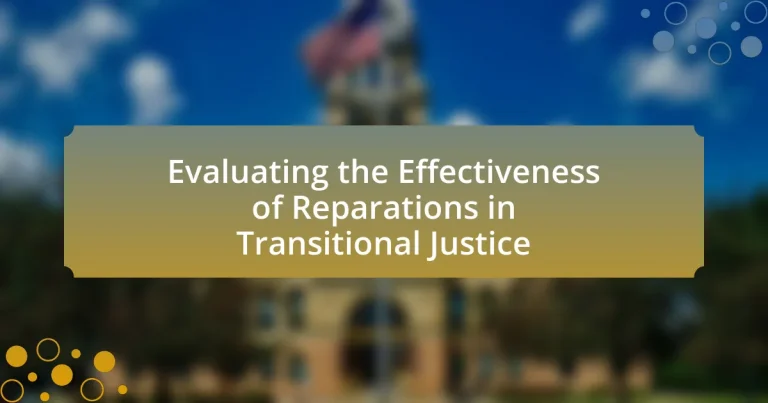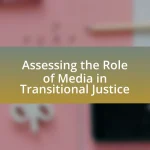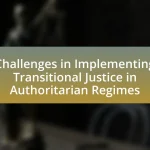Reparations in the context of transitional justice are measures aimed at compensating victims of human rights violations and restoring their dignity following periods of conflict or authoritarian rule. This article evaluates the effectiveness of reparations by examining their definitions, types, and cultural interpretations, as well as their importance in promoting healing and reconciliation within societies. It discusses the challenges associated with implementing reparations, including legal, financial, and social obstacles, and highlights best practices for enhancing their effectiveness. Additionally, the article analyzes case studies from various countries to illustrate the long-term impacts of reparations on social cohesion and economic recovery, while providing recommendations for future reparations initiatives.
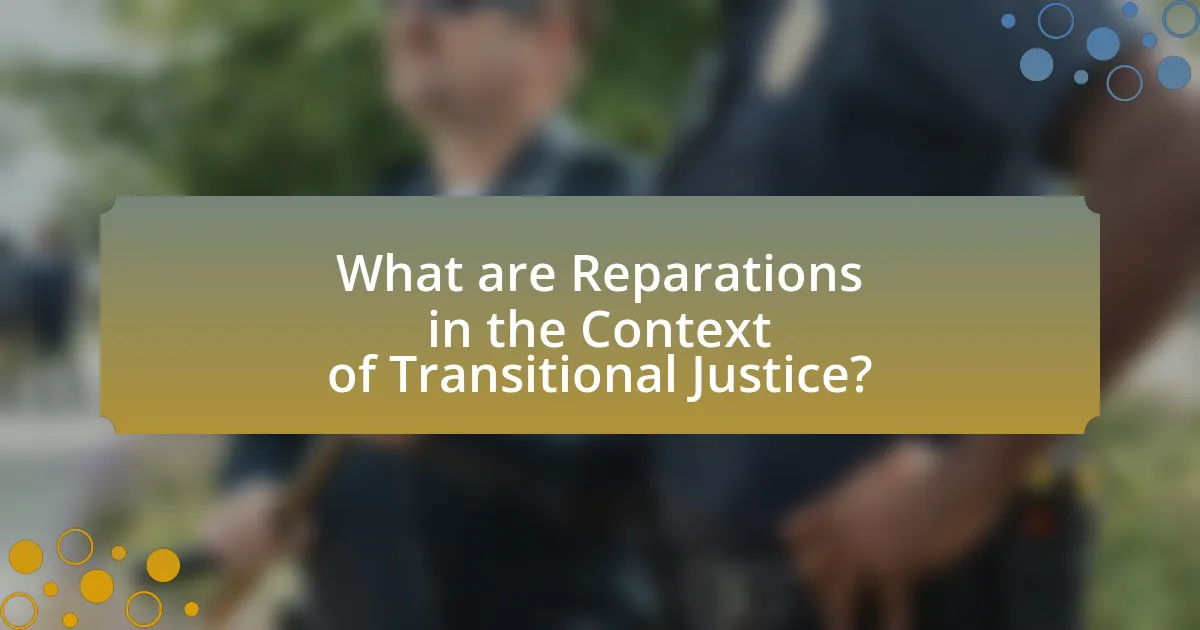
What are Reparations in the Context of Transitional Justice?
Reparations in the context of transitional justice refer to measures taken to compensate victims of human rights violations and restore their dignity after periods of conflict or authoritarian rule. These measures can include financial compensation, restitution of property, rehabilitation services, and public acknowledgment of the harm suffered. Historical examples, such as the reparations paid to Holocaust survivors by Germany, illustrate the role of reparations in addressing past injustices and promoting societal healing. Studies, including those by the United Nations, indicate that effective reparations can contribute to reconciliation and the prevention of future conflicts by acknowledging victims’ suffering and fostering a sense of justice.
How are Reparations Defined in Transitional Justice Frameworks?
Reparations in transitional justice frameworks are defined as measures taken to address the harm suffered by victims of human rights violations, aiming to provide acknowledgment, restitution, and compensation. These measures can include financial payments, rehabilitation services, and symbolic acts of recognition, which collectively seek to restore dignity and promote healing for affected individuals and communities. The United Nations’ Basic Principles and Guidelines on the Right to a Remedy and Reparation for Victims outlines that reparations should be proportional to the gravity of the violations and the harm suffered, emphasizing the importance of both material and immaterial forms of redress.
What Types of Reparations are Commonly Implemented?
Commonly implemented types of reparations include financial compensation, restitution of property, rehabilitation services, and symbolic measures such as public apologies or memorials. Financial compensation provides direct monetary payments to victims or their families, while restitution involves returning property or assets taken during injustices. Rehabilitation services may encompass medical care, psychological support, and social services aimed at helping victims recover. Symbolic measures serve to acknowledge past wrongs and promote healing within communities, often involving official apologies or the establishment of memorials to honor victims. These reparative actions are designed to address the harm caused by injustices and facilitate the process of reconciliation in transitional justice contexts.
How Do Different Cultures Interpret Reparations?
Different cultures interpret reparations through various lenses, often influenced by historical context, social values, and collective memory. For instance, in the United States, reparations discussions primarily focus on addressing the legacy of slavery and systemic racism, with proposals often emphasizing financial compensation and policy changes to rectify historical injustices. In contrast, countries like Germany have approached reparations for Holocaust victims through formal state compensation programs, reflecting a commitment to acknowledging past atrocities and fostering reconciliation. Additionally, Indigenous cultures may interpret reparations as a means to restore land rights and cultural heritage, emphasizing the importance of restoring relationships rather than merely providing financial restitution. These interpretations highlight the diverse ways in which societies seek to address historical grievances and promote healing.
Why are Reparations Considered Important in Transitional Justice?
Reparations are considered important in transitional justice because they serve to acknowledge and address the harms suffered by victims of past injustices. By providing financial compensation, restitution, or services, reparations aim to restore dignity and promote healing for individuals and communities affected by systemic violence or oppression. Historical examples, such as the reparations paid to Holocaust survivors by Germany, illustrate how reparations can facilitate societal reconciliation and contribute to the prevention of future atrocities by recognizing the state’s responsibility for past wrongs.
What Role Do Reparations Play in Healing Societies?
Reparations play a crucial role in healing societies by addressing historical injustices and fostering reconciliation. They provide financial compensation, acknowledgment of harm, and support for affected communities, which can help restore dignity and promote social cohesion. For instance, the Truth and Reconciliation Commission in South Africa highlighted that reparations contributed to national healing by recognizing the suffering of victims of apartheid, thereby facilitating a collective move towards unity. Studies show that societies that implement reparations often experience reduced tensions and improved trust among diverse groups, as seen in post-conflict nations like Rwanda, where reparative measures have been linked to societal stability and recovery.
How Do Reparations Contribute to Restorative Justice?
Reparations contribute to restorative justice by addressing historical injustices and facilitating healing for affected communities. They provide financial compensation, acknowledgment of harm, and support for community development, which helps restore dignity and promote reconciliation. For instance, the South African Truth and Reconciliation Commission implemented reparations for victims of apartheid, which included monetary payments and educational opportunities, demonstrating a commitment to restorative justice principles. This approach not only compensates victims but also fosters societal healing and encourages dialogue, essential components of restorative justice.
What Challenges are Associated with Implementing Reparations?
Implementing reparations faces several challenges, including legal, financial, and social obstacles. Legal challenges arise from the complexity of establishing liability and the historical context of injustices, making it difficult to identify responsible parties and beneficiaries. Financial challenges include securing adequate funding and determining the appropriate form of reparations, whether monetary compensation or other forms of restitution. Social challenges involve public perception and political will, as reparations can be contentious and provoke resistance from those who may feel unfairly burdened by the costs. These challenges are evident in various historical contexts, such as the reparations discussions in the United States for slavery and in Germany for Holocaust survivors, where debates over eligibility and the impact on societal cohesion continue to complicate the implementation process.
What Legal and Political Obstacles Exist?
Legal and political obstacles to reparations in transitional justice include legislative barriers, lack of political will, and conflicting interests among stakeholders. Legislative barriers often arise when existing laws do not accommodate reparations frameworks, making it difficult to implement compensation or restitution measures. Additionally, political will is frequently lacking due to the prioritization of other issues or fear of backlash from powerful groups opposed to reparations. Conflicting interests among various stakeholders, such as government entities, victims, and civil society organizations, can further complicate the establishment of a cohesive reparations program. These obstacles hinder the effectiveness of reparations in achieving justice and reconciliation in post-conflict societies.
How Do Economic Constraints Affect Reparations Programs?
Economic constraints significantly limit the implementation and effectiveness of reparations programs. These financial limitations can hinder the ability of governments or organizations to allocate sufficient resources for compensation, community development, and support services for affected populations. For instance, in countries facing economic downturns or high levels of debt, prioritizing reparations may be deprioritized in favor of immediate economic needs, leading to inadequate funding and implementation of reparative measures. Historical examples, such as the reparations for Japanese Americans interned during World War II, illustrate that limited budgets can restrict the scope and impact of reparations, resulting in insufficient compensation and support for the affected communities.
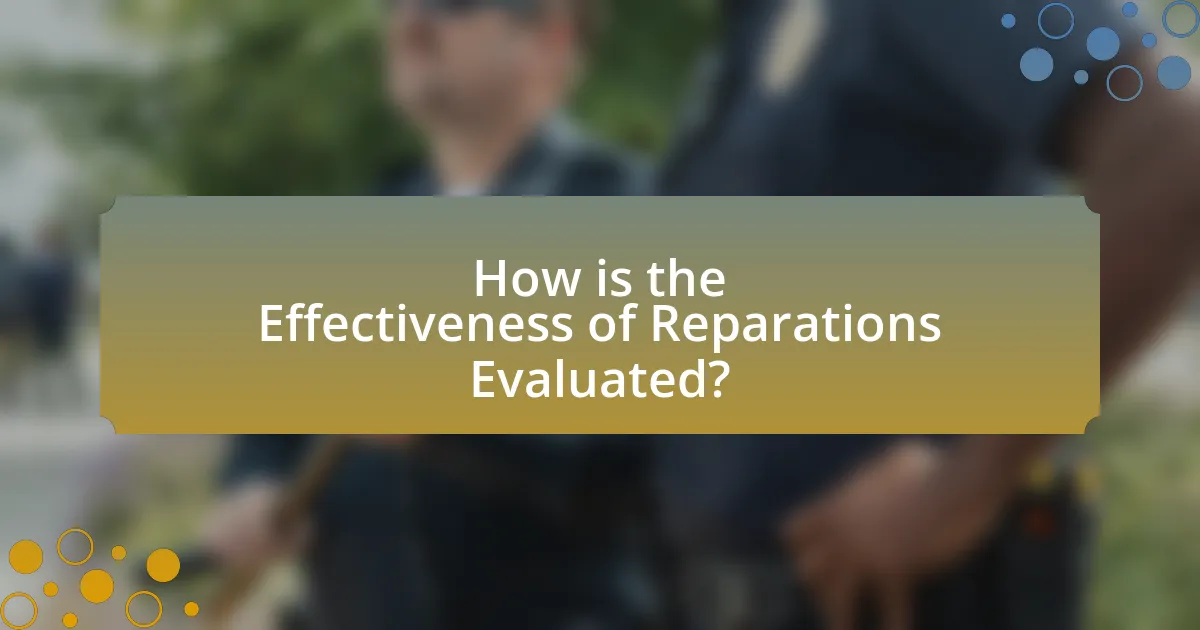
How is the Effectiveness of Reparations Evaluated?
The effectiveness of reparations is evaluated through various criteria, including the extent to which they address the harm suffered, promote healing, and contribute to social justice. Evaluators assess whether reparations meet the needs of affected individuals and communities, considering factors such as financial compensation, access to services, and acknowledgment of past injustices. Research indicates that successful reparations programs often incorporate community involvement and are tailored to the specific historical and cultural contexts of the affected populations, enhancing their impact and acceptance. For instance, the reparations program in South Africa post-apartheid included both financial compensation and public acknowledgment, which significantly contributed to national healing and reconciliation efforts.
What Metrics are Used to Assess the Success of Reparations?
Metrics used to assess the success of reparations include economic indicators, social cohesion, psychological well-being, and community engagement. Economic indicators often involve measuring changes in income levels, employment rates, and access to resources for affected populations. Social cohesion metrics assess the degree of trust and relationships within communities post-reparation, often evaluated through surveys and community feedback. Psychological well-being is gauged through mental health assessments and surveys that measure trauma recovery among beneficiaries. Community engagement metrics focus on participation rates in reparative programs and initiatives, indicating the level of acceptance and integration of reparations within the community. These metrics provide a comprehensive framework for evaluating the effectiveness of reparations in achieving justice and healing.
How Do Stakeholder Perspectives Influence Effectiveness Evaluations?
Stakeholder perspectives significantly influence effectiveness evaluations by shaping the criteria and metrics used to assess outcomes. Different stakeholders, such as victims, government officials, and NGOs, prioritize varying aspects of reparations, leading to diverse interpretations of what constitutes success. For instance, victims may focus on emotional healing and acknowledgment, while policymakers might emphasize cost-effectiveness and implementation efficiency. Research indicates that these differing priorities can lead to conflicting evaluations; a study by the International Center for Transitional Justice highlights that inclusive stakeholder engagement in evaluation processes enhances the legitimacy and perceived effectiveness of reparations programs. Thus, stakeholder perspectives are crucial in determining the frameworks and standards applied in effectiveness evaluations.
What Role Does Public Perception Play in Evaluating Reparations?
Public perception significantly influences the evaluation of reparations by shaping societal attitudes and political will. When the public views reparations as a moral imperative, it can lead to increased support for policies aimed at addressing historical injustices, as seen in various movements advocating for reparations in the United States and South Africa. For instance, surveys indicate that public support for reparations correlates with awareness of historical injustices, such as slavery and apartheid, demonstrating that informed public opinion can drive legislative action. Conversely, negative perceptions or misconceptions about reparations can hinder progress, as seen in debates where reparations are framed as divisive or unfair. Thus, public perception acts as a critical barometer for the feasibility and implementation of reparative measures in transitional justice contexts.
What Case Studies Provide Insight into Reparations Effectiveness?
Case studies that provide insight into reparations effectiveness include the reparations programs in South Africa, Germany, and the United States. The South African Truth and Reconciliation Commission (TRC) offered reparations to victims of apartheid, which highlighted the importance of acknowledgment and public recognition in healing processes. Germany’s reparations to Holocaust survivors, amounting to over $70 billion, demonstrated the long-term commitment to addressing historical injustices and the impact of financial compensation on survivors’ well-being. In the United States, the Civil Liberties Act of 1988 provided reparations to Japanese Americans interned during World War II, illustrating the significance of formal apologies and financial restitution in restoring dignity. These case studies collectively underscore the multifaceted nature of reparations and their varying degrees of effectiveness in promoting justice and reconciliation.
How Have Countries Like South Africa Implemented Reparations?
Countries like South Africa have implemented reparations primarily through the Truth and Reconciliation Commission (TRC), established in 1995. The TRC aimed to address the injustices of apartheid by documenting human rights violations and providing a framework for reparations. The South African government allocated funds for individual reparations, which included financial compensation, educational opportunities, and healthcare services for victims of apartheid. According to the TRC’s final report, over 20,000 individuals received reparations, highlighting the government’s commitment to acknowledging past wrongs and promoting healing.
What Lessons Can Be Learned from the Experience of Germany?
The experience of Germany teaches that comprehensive reparations can facilitate reconciliation and healing in post-conflict societies. Following World War II, Germany implemented extensive reparations for Holocaust survivors and other victims, which included financial compensation, social services, and acknowledgment of wrongdoing. This approach not only addressed the needs of victims but also fostered a culture of accountability and remembrance, as evidenced by the establishment of memorials and educational programs. The German model demonstrates that reparations, when coupled with a commitment to historical truth and justice, can contribute significantly to societal healing and the prevention of future atrocities.
What Are the Long-Term Impacts of Reparations on Societies?
The long-term impacts of reparations on societies include enhanced social cohesion, improved economic conditions for marginalized groups, and a greater sense of justice and acknowledgment of historical wrongs. Research indicates that reparations can lead to reduced inequality by providing financial resources and opportunities to historically disadvantaged populations, thereby fostering economic growth and stability. For instance, the implementation of reparations in post-apartheid South Africa aimed to address systemic injustices and has shown some positive effects on social integration and economic empowerment among previously oppressed communities. Additionally, studies have demonstrated that societies that acknowledge and rectify past injustices through reparations often experience lower levels of conflict and increased trust in governmental institutions, contributing to long-term peace and stability.
How Do Reparations Affect Social Cohesion Over Time?
Reparations can enhance social cohesion over time by addressing historical injustices and fostering a sense of recognition and healing among affected communities. When reparations are implemented, they often lead to improved relationships between marginalized groups and the broader society, as seen in post-apartheid South Africa, where the Truth and Reconciliation Commission aimed to promote national unity through acknowledgment of past wrongs. Studies indicate that societies that engage in reparative justice tend to experience lower levels of conflict and increased trust among diverse groups, as reparations signal a commitment to equity and justice. For instance, research by the International Center for Transitional Justice highlights that reparations can contribute to social stability by reducing grievances and promoting dialogue, ultimately leading to a more cohesive society.
What Evidence Exists Regarding Economic Recovery Post-Reparations?
Evidence regarding economic recovery post-reparations indicates that reparations can lead to significant improvements in economic conditions for affected communities. For instance, studies have shown that in countries like South Africa, the implementation of reparations for apartheid victims has contributed to increased access to education and healthcare, which are critical for economic advancement. Additionally, research by the Institute for Justice and Reconciliation highlights that reparations can enhance social cohesion and trust in institutions, further facilitating economic growth. Furthermore, the case of Germany’s reparations to Holocaust survivors demonstrates a direct correlation between reparations and improved economic stability for individuals and communities, as many survivors were able to invest in businesses and education, leading to long-term economic benefits.

What Best Practices Can Enhance the Effectiveness of Reparations?
Best practices that can enhance the effectiveness of reparations include ensuring inclusivity, providing comprehensive support, and establishing clear accountability mechanisms. Inclusivity involves engaging affected communities in the design and implementation of reparations programs, which fosters trust and ensures that the needs of diverse groups are met. Comprehensive support encompasses not only financial compensation but also access to education, healthcare, and psychological services, addressing the multifaceted impacts of harm. Establishing clear accountability mechanisms ensures that reparations are delivered transparently and that there are consequences for non-compliance, which can enhance public confidence in the process. These practices are supported by case studies, such as the reparations programs in South Africa and Canada, which demonstrate that inclusive and comprehensive approaches lead to more effective outcomes in transitional justice contexts.
How Can Stakeholder Engagement Improve Reparations Programs?
Stakeholder engagement can significantly improve reparations programs by ensuring that the voices and needs of affected communities are prioritized in the design and implementation processes. Engaging stakeholders, such as victims, community leaders, and advocacy groups, fosters a sense of ownership and trust, which is crucial for the legitimacy and effectiveness of reparations initiatives. Research indicates that programs that incorporate stakeholder feedback are more likely to address the specific grievances and historical injustices faced by communities, leading to more tailored and impactful reparations. For example, the Truth and Reconciliation Commission in South Africa highlighted the importance of community involvement in shaping reparative measures, resulting in programs that were more responsive to the needs of victims. This participatory approach not only enhances the relevance of reparations but also promotes social cohesion and healing within affected communities.
What Strategies Foster Inclusivity in Reparations Processes?
Strategies that foster inclusivity in reparations processes include community engagement, diverse stakeholder representation, and transparent decision-making. Community engagement ensures that affected populations actively participate in the design and implementation of reparations, which enhances legitimacy and relevance. Diverse stakeholder representation, including marginalized groups, allows for a broader perspective on the needs and experiences of those impacted by injustices. Transparent decision-making processes build trust and accountability, as seen in the Truth and Reconciliation Commission in South Africa, where public hearings allowed victims to share their stories and influence reparative measures. These strategies collectively contribute to a more equitable and effective reparations framework.
How Can Transparency and Accountability Be Ensured?
Transparency and accountability can be ensured through the implementation of clear policies, regular audits, and public reporting mechanisms. Establishing a framework that mandates the disclosure of information related to reparations, including funding sources and distribution processes, fosters trust and allows stakeholders to hold authorities accountable. For instance, countries like South Africa have utilized public hearings and independent oversight bodies to monitor reparations, demonstrating that structured transparency measures can enhance accountability in transitional justice processes.
What Recommendations Can Be Made for Future Reparations Initiatives?
Future reparations initiatives should prioritize inclusive stakeholder engagement to ensure that the voices of affected communities are central to the design and implementation processes. Engaging these communities can lead to more tailored and effective reparations that address specific historical injustices. Additionally, reparations should incorporate a combination of financial compensation, social services, and community development programs to holistically address the needs of affected populations. Evidence from successful reparations programs, such as South Africa’s Truth and Reconciliation Commission, demonstrates that multifaceted approaches can foster healing and reconciliation. Furthermore, establishing clear metrics for evaluating the impact of reparations can enhance accountability and transparency, ensuring that initiatives meet their intended goals and adapt over time based on feedback and outcomes.
How Can Lessons from Past Experiences Shape Future Policies?
Lessons from past experiences can shape future policies by providing evidence-based insights that inform decision-making processes. Historical examples, such as the reparations provided to Holocaust survivors, demonstrate how acknowledging past injustices can lead to restorative measures that promote social healing and reconciliation. Additionally, studies indicate that countries implementing reparations, like South Africa post-apartheid, have seen improvements in societal trust and stability, reinforcing the importance of learning from previous outcomes to design effective policies. By analyzing these cases, policymakers can identify best practices and potential pitfalls, ensuring that future reparative measures are more effective and contextually relevant.
What Role Should International Organizations Play in Supporting Reparations?
International organizations should play a crucial role in supporting reparations by providing funding, facilitating dialogue, and ensuring accountability for past injustices. These organizations, such as the United Nations and regional bodies, can allocate resources to assist affected communities in receiving reparations, which can include financial compensation, social services, and acknowledgment of harm. For instance, the UN has established mechanisms for reparations in various contexts, such as the Trust Fund for Victims in the International Criminal Court, which demonstrates a commitment to addressing the needs of victims. Furthermore, international organizations can promote best practices and guidelines for reparations, drawing on successful case studies like South Africa’s Truth and Reconciliation Commission, which highlighted the importance of reparative measures in healing societal wounds. By leveraging their influence and expertise, international organizations can enhance the effectiveness of reparations in transitional justice processes.
What Practical Steps Can Be Taken to Implement Effective Reparations?
Practical steps to implement effective reparations include establishing a legal framework, conducting thorough assessments of harm, and ensuring community involvement in the reparations process. A legal framework provides the necessary guidelines for reparations, ensuring accountability and clarity in the process. Assessments of harm involve identifying affected individuals and communities, quantifying losses, and understanding the specific needs for restitution. Community involvement ensures that reparations are culturally relevant and address the actual needs of those harmed, fostering trust and engagement. Historical examples, such as the reparations paid to Holocaust survivors and the Truth and Reconciliation Commission in South Africa, demonstrate the importance of these steps in achieving meaningful reparations.
